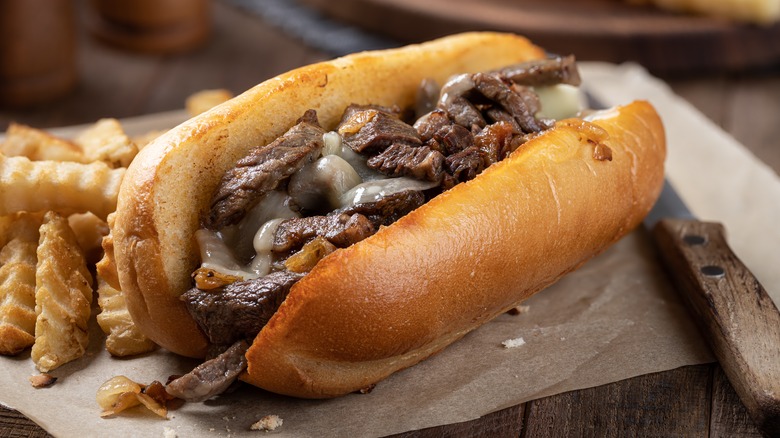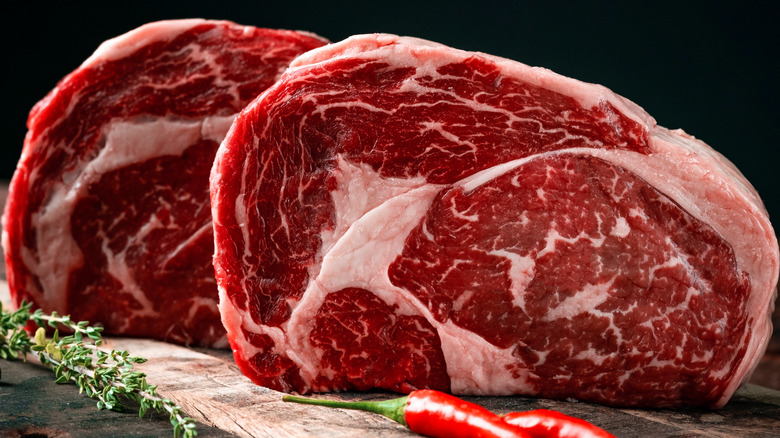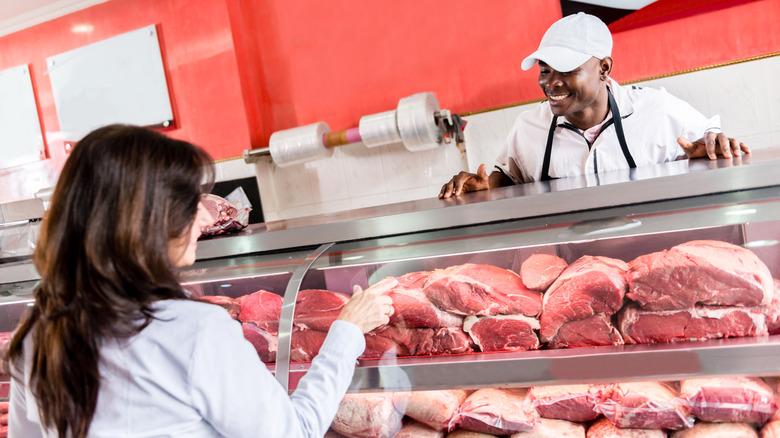What's The Best Meat To Use In A Philly Cheese Steak?
One of the most endearing symbols of the city of Philadelphia is the cheesesteak sandwich. Piled high with chopped steak, peppers, onions, and mushrooms — and topped with hot, melty cheese — it's what Victor Fiorillo of Philadelphia Magazine says is the city's "signature icon, the most Philly of Philly symbols, recognized (and eaten) around the world."
No trip to the City of Brotherly Love is complete without a look at the Liberty Bell, a jog up the steps to the Philadelphia Museum of Arts like Rocky Balboa, and a visit to the famous cheesesteak rivals Pat's and Geno's. You don't have to hop on a flight or take a road trip to Philly to have a classic cheesesteak sandwich, however, because they're very simple to make. You don't even really need a recipe; you just need the right ingredients. Any Philadelphian will tell you that the cheese must be either Cheez Whiz, American, or provolone, and that the bread should be a soft hoagie roll, and finally, that the steak needs to be good quality ribeye.
Why ribeye is the top choice
When it comes to the meat, you might be tempted to cut corners while making a cheesesteak, but this would be a mistake. Just because it's only a sandwich doesn't mean you should use any old protein. The word "steak" is right in the name, and the entire flavor profile of the sandwich is built on that meat, so you should take your steak seriously.
Ribeye comes from the center of the rib-section of a cow, and it contains a lot of intramuscular fat — that is, the fat that's interspersed within the fibers of muscle. This is also known as "marbling," because it creates a pattern in the meat that looks a lot like marble rock. This fat tastes very rich and buttery, which is what makes ribeye steaks and prime rib so delicious. The fat in the marbling also protects the meat from drying out while you're cooking it, so even overcooked ribeye steaks are still juicy.
Plus, the meat is cut from the animal's rib cage muscles, which don't get exercised often by the cow, so they yield super tender meat. All of these factors combined make ribeye the perfect meat for cheesesteaks. Although the meat is sliced thinly or chopped up and cooked over high heat, it will still remain very flavorful and juicy — even when it's cooked all the way through on a griddle, like they do in Philly.
What to look for when shopping for ribeye
When shopping for cheesesteak supplies, know what you're looking for before you hit the meat counter. You don't want to waste money on iffy meat, and ribeye is expensive.
The most important thing to look for in your steaks is the intramuscular fat. The best ribeye for cheesesteaks should have evenly distributed, white-colored marbling across the slab of meat. Also, look for steaks that are labeled as "prime," as this will have the most marbling; educating yourself ahead of time on the difference between USDA prime steak and everything else will come in handy here. The meat should be very red, with no gray or brown tinge, which would indicate that it's getting old.
Ribeye steaks are often sold on and off the bone, and steaks on the bone are frequently purported to be the most flavorful. But, since you're going to cut your steak up and cook it well-done, don't bother with buying anything on the bone, since that would just be a waste of money. You also don't need a lot of steak to make a sandwich, since you'll be adding peppers, onions, and mushrooms; factor in about 4-5 ounces of meat per sandwich for the best ratio. Then, top it with some cheese, and you'll have the perfect cheesesteak.


